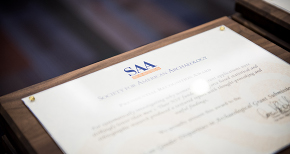Outstanding Public Archaeology Initiative Award
Nomination/Submission Deadline: 20 Dec 2025
Award Description
The Outstanding Public Archaeology Initiative Award continues the tradition begun by the Award for Excellence in Public Education (1997–2020) of recognizing exemplary public engagement efforts but refocuses on discrete projects (defined as a project with a clear start and end date). This award recognizes the best short-term initiatives such as (but not limited to) the following: exhibits, lesson plans, products, or other short-term outreach projects. Groups should only submit a nomination for either the Outstanding Public Archaeology Initiative Award or the Excellence in Public Archaeology Programming Award in a given year. Potential applicants and nominees who feel their work is eligible are encouraged to contact the committee chair by early November to solicit guidance.
Who Is Eligible to Submit Nominations or Apply for the Award
Any member of SAA may submit a nomination file, although awardees are not required to be members of the SAA.
Nomination/Submission Materials Required
Nominators will assemble a nomination packet that includes the following: 1) the Award Nomination Form; 2) a letter of nomination that identifies the outstanding project being nominated and summarizes its accomplishments; 3) supporting evidence of accomplishments; and 4) endorsements (no more than three). The nomination letter and narrative should address the following topics:
- Overview: Describe the project being nominated, including its goals and how it is made available to the public.
- Creativity: Discuss the innovative aspects of the initiative.
- Leadership: Explain how the project serves as an exemplary model of public education related to archaeology.
- Public Impact: Document the impact of the initiative on relevant publics beyond the discipline of archaeology (general public, special interest groups, pre-collegiate or nontraditional students, others).
- Ethics: Mention ways in which the initiative promotes an understanding of ethical archaeology, such as appropriate presentation of archaeological methods, encouragement of site stewardship, connection and consultation with descendants, and other public involvement.
The nomination file should include details (including photos or samples, if possible) of the specific project and supporting materials that document results of the specific initiative. This material should clearly demonstrate the case being made in the nomination narrative. For example, supporting materials might document the impact of a specific project in terms of the number of members of the public involved, personnel qualification, the frequency or longevity of programs offered, formal evaluation results, and/or feedback from the audience. Endorsements from secondary nominators are welcomed (please, no more than three). Prior nomination does not exclude consideration of a nominee in subsequent years. Project designers may nominate their own work. Nominations should be for initiatives conducted or created within the last five years. Electronic submissions are encouraged and all parts should be submitted as a single pdf.
Other Special Requirements
Prior to any award recommendation being finalized and publicly announced, anyone recommended for an award, scholarship, or grant will be required to certify the following:
(a) I am not and have not ever been the subject of a discrimination or harassment lawsuit or related administrative complaint that resulted in an adverse finding; and(b) I do not have and have not had a current or pending disciplinary action such as suspension or termination of registration, resulting from a Register of Professional Archaeologists’ grievance investigation.
Nature of Award (e.g. monetary, medal, symposium)
The awardee is recognized by the SAA through a plaque presented during the business meeting held at the Annual Meeting, a citation in The SAA Archaeological Record, and acknowledgment on the awards page of the SAA Website.
Current Committee Charge
Committee Composition
Committee composition is one chair and at least four members.
Term Length
Term length is three years. Individuals ending their terms cycle off the committee at the close of the Business Meeting held during the SAA Annual Meeting, and new appointees begin their terms at this time.
Award Cycle
Committee Chair and End of Term
Sara E. Ayers-Rigsby [2027]
Committee Chair Contact Information
Committee Members and Ends of Terms
Selection or Evaluation Criteria
Nominations are reviewed individually by members of the Awards for Excellence in Public Education Committee, who select a recipient based on the following criteria: public impact, creativity in programming, leadership, and promotion of archaeological ethics. The selection process is heavily guided by the evaluation rubric as well as a consideration of the holistic impact of each project. The committee reserves the right not to make an award in any given year if the nomination pool does not merit doing so.
Committee Deliberation Process (e.g. dates, venue)
After reviewing all nominations individually, committee members meet electronically and/or via telephone conference after the submission deadline has passed to select the winner.
2025 Chinese Railroad Workers Project, Terrace Utah (2018-2024)
2024 Emergence and Evolution of Carolina's Coastal Economy
2023 The Massachusetts Archaeological Society and the Robert S. Peabody Institute for Archaeology
2022 The Waccamaw Indian People, Coastal Carolina University, and the Horry County Museum
2021 "Archaeology in the Time of Black Lives Matter” Virtual Panel


